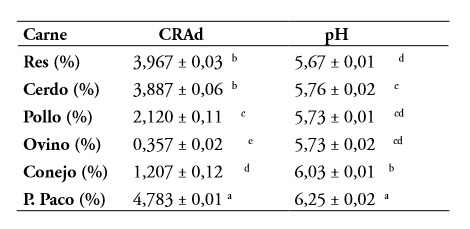Efecto de la temperatura en la capacidad de retención de agua y pH en carne de res, cerdo, pollo, ovino, conejo y pescado paco
DOI:
https://doi.org/10.33017/RevECIPeru2010.0024/Keywords:
meat, cra, ph, temperature, emulsion.Abstract
The present research was developed in the laboratory of meat unas. The aims were to determine the capacity of water retention and the ph in fresh meat (cra), defrosted (crad), and cooked (crac), at different temperatures in the meat of beef, pork, chicken, sheep, rabbit and paco fish. as well as to produce sausage with the meat that has better water retention capacity and to evaluate the emulsion stability (ee) and capacity of water retention of the sausage (crae). We analyzed the capacity of water retention in fresh meat, defrosted and cooked (at 77, 82 and 87 °c). The data was expressed by the media ± sem, we used variance analyses of complete design at random (Dca) and the tukey test (p<0,05). The best capacity of water retention in fresh meat corresponded to paco fish cra i (25 %) and cra ii (17,333 %) and Ph (6,39), in defrosted meat corresponded to sheep crad (0,357 %) and ph (5,133), in cooked meat at 77 °c temperature corresponded to chicken crac (6,62 %) and ph (5,76), and at 82 °c and 87 °c corresponded to sheep crac (9,31 and 18,953 % respectively) and ph (5,75 y 5,78 respectively). We also carried out the analyses of emulsion stability and the capacity of water retention of the sausages of pork and sheep. The data were expressed by the media ± sem, We used the test of t - student (p<0,05). The best emulsion stability (ee) and capacity of water retention (crae) corresponded to the sausage elaborated with pork ee (8,53 ml/100g of meat) and crae (25 %).


